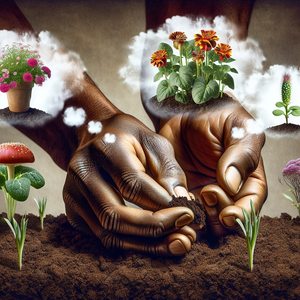Cacao: The Currency of the Maya Civilization

The Maya civilization, which thrived in Mesoamerica from around 250 to 900 AD, established a complex economy rooted in agriculture, trade, and cultural practices. Among the various goods traded, cacao emerged as a particularly valuable commodity. The Mayans not only consumed cacao in the form of a frothy beverage, often flavored with spices and honey, but also utilized it as a currency for trade. Historical records indicate that cacao beans were used to pay for goods and services. For instance, a turkey could be purchased for approximately 100 cacao beans, while a tamale might cost around 10 beans. This system of trade highlights how cacao was not merely a luxury item but an essential component of daily life and commerce. The value of cacao was so significant that it was often carried in pouches and exchanged in marketplaces, demonstrating its role as a standardized medium of exchange. The integration of cacao into economic transactions reflects the Maya's understanding of supply and demand. As cacao became more popular, its value increased, leading to more sophisticated trading networks. This reliance on cacao as currency allowed for greater economic complexity, enabling the Maya to engage in long-distance trade with other Mesoamerican cultures.
Economic Implications of Cacao Cultivation
The cultivation of cacao was integral to the Mayan economy, reflecting their innovative agricultural practices. The Mayans developed diverse farming techniques, including slash-and-burn agriculture, which allowed for the effective cultivation of cacao alongside staple crops like maize and beans. This polyculture not only ensured food security but also diversified the economic base of the society. Cacao cultivation required specific conditions—shaded environments, moisture, and well-drained soil—which led the Maya to establish plantations in suitable areas. These plantations became vital economic centers, generating wealth not just for individual farmers but also for the broader community. The surplus production of cacao facilitated trade with neighboring civilizations, creating networks that reached far beyond the Mayan territories. Moreover, the economic implications of cacao cultivation extended to labor practices. The demand for cacao led to the establishment of a labor force that included both free workers and those bound by servitude. This dynamic played a significant role in shaping social structures and economic relationships within Mayan society. The wealth generated from cacao contributed to the construction of monumental architecture and the development of city-states, further illustrating the importance of this crop in fostering societal advancement.
Cacao and Social Hierarchy
Cacao's significance extended into the realm of social stratification. The consumption and use of cacao were often reserved for the elite, particularly within the context of rituals and ceremonies. The ruling classes used cacao as a display of wealth and power, serving the beverage during important gatherings and feasts. This exclusivity reinforced social hierarchies, as those who could afford cacao showcased their status while commoners had limited access. Additionally, cacao’s role in rituals emphasized its cultural importance. The Maya believed that cacao was a gift from the gods, and its use in religious ceremonies further solidified its revered status. Offerings of cacao to deities were common, intertwining economic activity with spiritual beliefs and practices. This intersection of religion and economics underscored the centrality of cacao in Mayan life, illustrating how a simple agricultural product could embody cultural, social, and economic dimensions. The ceremonial use of cacao also fostered community bonds among the elite and served as a means of diplomacy. Sharing cacao during rituals and feasts allowed for the strengthening of alliances and the negotiation of political relationships, thereby reinforcing the social fabric of the civilization.
Cacao was much more than a mere commodity in the ancient Maya civilization; it was a vital currency that shaped economic interactions, a symbol of wealth that delineated social classes, and a culturally significant item deeply embedded in religious practices. The legacy of cacao continues to resonate today, not only in our culinary experiences but also in our understanding of how societies use resources to define and navigate their economies and social structures. By exploring the multifaceted role of cacao in Mayan society, we gain insight into the complexities of ancient economies and the enduring human connection to both agriculture and culture. Thus, cacao stands as a testament to the ingenuity and sophistication of the Maya civilization, reflecting the intricate tapestry of trade, culture, and social dynamics that defined their world. Understanding this rich history allows us to appreciate not just the chocolate we enjoy today but also the profound cultural significance of cacao in shaping one of the most fascinating civilizations in human history.
Ethnobotanist
Universities, research institutions, and cultural heritage organizations
Core Responsibilities
Conduct research on the historical uses of plants, focusing on their cultural and economic significance in ancient societies.
Collaborate with archaeologists to analyze plant remains and artifacts found at historical sites.
Publish findings in academic journals and present research at conferences.
Required Skills
Strong understanding of botany and anthropology, with a focus on Mesoamerican cultures.
Proficiency in data analysis and interpretation of archaeological findings.
Experience in field research and ethnographic studies.
Agricultural Archaeologist
Archaeological firms, museums, and universities
Core Responsibilities
Investigate ancient agricultural practices and their impact on societal development, focusing on crops like cacao.
Analyze soil samples and plant remains to reconstruct historical farming techniques.
Work with multidisciplinary teams to enhance understanding of past civilizations.
Required Skills
Background in archaeology or anthropology with specific knowledge in agricultural systems.
Familiarity with laboratory techniques for analyzing organic residues.
Ability to communicate findings effectively through reports and presentations.
Cultural Heritage Manager
Museums, cultural organizations, and government agencies
Core Responsibilities
Develop and implement programs to preserve and promote the cultural significance of ancient agricultural practices, such as cacao cultivation.
Engage with local communities to raise awareness and support for heritage conservation efforts.
Organize educational programs and exhibitions that highlight the historical importance of cacao in Mesoamerican societies.
Required Skills
Strong background in cultural heritage management, museum studies, or a related field.
Excellent project management and communication skills.
Experience working with diverse stakeholders, including government entities and non-profits.
Food Historian
Academic institutions, publishing companies, and media production firms
Core Responsibilities
Research and write about the historical significance of food items, particularly cacao, in various cultures.
Analyze recipes, texts, and artifacts to understand food practices and trade in ancient civilizations.
Contribute to publications and documentaries on food history.
Required Skills
Expertise in culinary history, anthropology, or a related field.
Strong writing and research abilities, with a keen eye for detail.
Familiarity with historical texts and archaeological findings.
Sustainable Agriculture Consultant
Environmental NGOs, agricultural cooperatives, and government agencies
Core Responsibilities
Advise organizations on sustainable farming practices, drawing lessons from ancient agricultural systems such as those used by the Maya for cacao cultivation.
Develop strategies for crop diversification and soil conservation based on historical practices.
Conduct workshops and training sessions for farmers and agricultural businesses.
Required Skills
Knowledge of sustainable agriculture, agroecology, or environmental science.
Ability to analyze current farming practices and recommend improvements.
Strong communication and interpersonal skills for engaging with diverse audiences.


